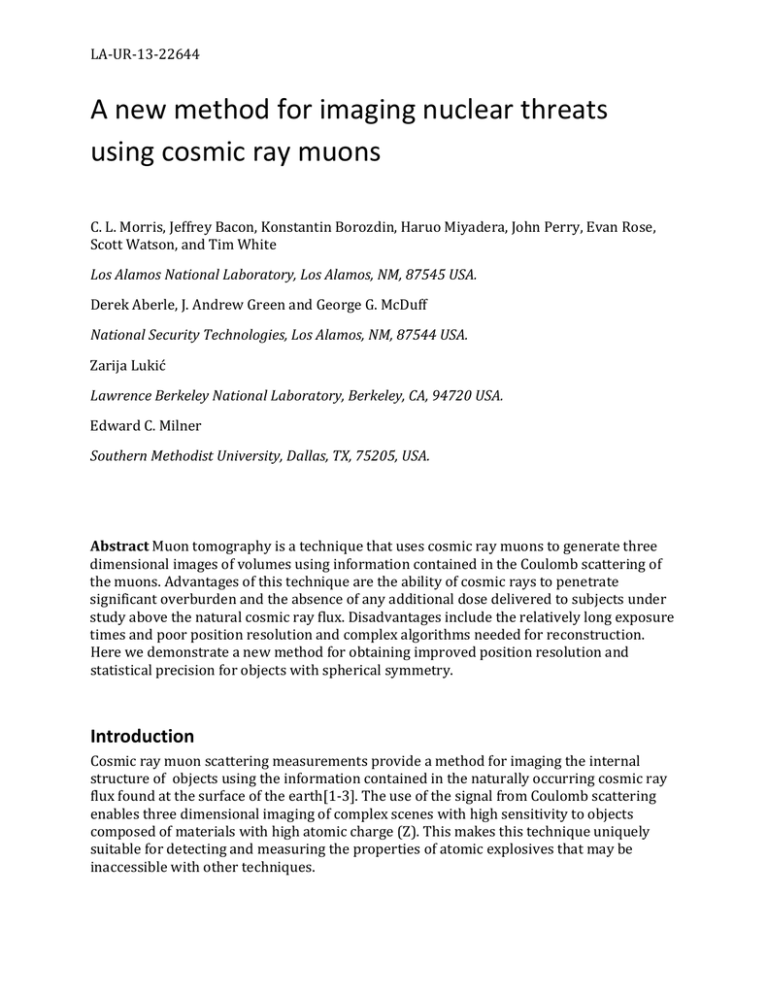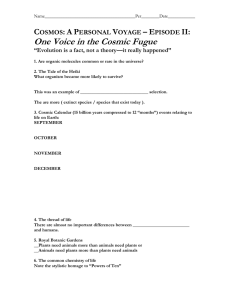A new method for imaging nuclear threats using cosmic ray muons
advertisement

LA‐UR‐13‐22644 A new method for imaging nuclear threats using cosmic ray muons C.L.Morris,JeffreyBacon,KonstantinBorozdin,HaruoMiyadera,JohnPerry,EvanRose, ScottWatson,andTimWhite LosAlamosNationalLaboratory,LosAlamos,NM,87545USA. DerekAberle,J.AndrewGreenandGeorgeG.McDuff NationalSecurityTechnologies,LosAlamos,NM,87544USA. ZarijaLukić LawrenceBerkeleyNationalLaboratory,Berkeley,CA,94720USA. EdwardC.Milner SouthernMethodistUniversity,Dallas,TX,75205,USA. AbstractMuontomographyisatechniquethatusescosmicraymuonstogeneratethree dimensionalimagesofvolumesusinginformationcontainedintheCoulombscatteringof themuons.Advantagesofthistechniquearetheabilityofcosmicraystopenetrate significantoverburdenandtheabsenceofanyadditionaldosedeliveredtosubjectsunder studyabovethenaturalcosmicrayflux.Disadvantagesincludetherelativelylongexposure timesandpoorpositionresolutionandcomplexalgorithmsneededforreconstruction. Herewedemonstrateanewmethodforobtainingimprovedpositionresolutionand statisticalprecisionforobjectswithsphericalsymmetry. Introduction Cosmicraymuonscatteringmeasurementsprovideamethodforimagingtheinternal structureofobjectsusingtheinformationcontainedinthenaturallyoccurringcosmicray fluxfoundatthesurfaceoftheearth[1‐3].TheuseofthesignalfromCoulombscattering enablesthreedimensionalimagingofcomplexsceneswithhighsensitivitytoobjects composedofmaterialswithhighatomiccharge(Z).Thismakesthistechniqueuniquely suitablefordetectingandmeasuringthepropertiesofatomicexplosivesthatmaybe inaccessiblewithothertechniques. LA‐UR‐13‐22644 Ifanuclearmaterialhasbeendetecteditisimportanttobeabletomeasuredetailsofits constructioninordertocorrectlyevaluatethethreat.Thefluxofcosmicraysislowsoit takesverylongexposurestoproduceimageswithhighresolution.Inthispaperweshow howonecantakeadvantageofsphericalsymmetrytoimprovethestatisticalprecisionof muonimaging. Three Dimensional Imaging Althoughcosmicraysarehighlypenetratingandcanimagethroughconsiderable overburden,thefluxislimited.Thetimesrequireddetectingthepresenceofquantitiesof uraniumorplutoniumnecessarytocreateanuclearexplosionareontheorderofminutes, andthetimesneededtoimagethesedeviceswith~2cmresolutionareontheorderof hours. ImagingwithcosmicraysisbasedonmeasuringthemultipleCoulombscatteringofthe muons.Thedominantpartofthemultiplescatteringpolar‐angulardistributionisGaussian: 2 dN N 2 0 2 e , d 20 2 1) theFermiapproximation,whereisthepolarangleand0isthemeanmultiplescattering angle,whichisgivenapproximatelyby: 0 14.1 MeV p l X0 2) Themuonmomentumandvelocityarepandrespectively,listhematerialthickness,and X0istheradiationlengthforthematerial.Thisequationneedstobeconvolvedwiththe cosmicraymomentumspectruminordertodescribetheangulardistribution. Thereareseveralalgorithmsforgeneratingtomographicimagesusingtheinputandthe outputtrajectoriesofthecosmicraysdescribedbySchultzetal.[2]Hereweuseavery simplemethodwithascenecomposedofvoxels.Foreachvoxelaone‐dimensional histogramofscatteringanglein1mradstepsfrom0to200mradiscreated.Thehistogram isincrementedforeverycosmicrayforwhichtheincidentcosmicrayinterceptsthevoxel andforwhichthedistancebetweentheinputandtheoutputcosmicraysintheplaneofthe voxelislessthan2cm.Forlargescatteringanglesthisrequirementassociatesmeasured scatteringeventswithdefinedvoxelsinwhichthemostofthescatteringoccurred. Thescatteringdistributionforeachvoxelisfittedwithamodelthatusessevenmomentum groups,[4]pi,toapproximatethemuonspectrumwith, LA‐UR‐13‐22644 2 dN A 2 sin( ) i2 e 20 i d 0i 0i , 3) 14.1 l pi X 0 toapproximatethemuonenergydistribution. Themodelhasbeencalibratedwithdatatakenthroughthreethicknessesoflead,5.08, 10.16and15.24cm.Theamplitudes,Ai,ofeachenergygroup,aswellastheintrinsic angularresolutionandafixednumberofradiationlengthsduetothedrifttubesandother structuralelementsofthemuondetectorswerefittedtominimizethelogarithmofthe likelihoodfunctionassumingthedataweredescribebyaPoisondistribution.Thismodel doesnotaccountforchangesintheshapeofthemuonspectrumduetostopping.A maximumlikelihoodfittothesetofleaddataisshowninError!Referencesourcenot found..Alsoshownisthedecompositionofoneofthedatasetsintoitsmomentumgroups. Figure1)Multi‐groupfittotheleadcalibrationdata.Ontheleftisaplotofthefitstodifferent thicknessesoflead,theplotontherightshowsthedecompositionofthefitintoitsmultipleGaussian components. Imageswereconstructedbyfittingtheangulardistributionforeachvoxeltoobtainthe averagenumberofradiationlengthsofmaterialthattheensembleofhistogramentrieshas traversed.Thisreconstructionalgorithmisscalabletolargedatasets,issimpletocompute, andprovidesnearoptimaluseofthescatteringinformation.However,itdoesn’toptimally usethevertexinformation. Wehaveimagedseveralsphericallysymmetricobjects:nestedsphericalshellsofcopper andtantalum,thecoppershellalone,andahollowleadball.Theouterradiiwere6.5,4.5, and10cmandtheinnerradiiwere4.5,1,and2.5cmforthecopper,tantalumandlead LA‐UR‐13‐22644 shellsrespectively.Cartesianslicesthroughthethreedimensionaltomograms,centeredon theobject,areshowninFigure2. Figure2)Cartesianslicesthroughthetomographsofthethreeobjects.Theyarepresentedonthe samepositionandgreyscales.Thegreyscaleislinearbetween0and80radiationlengthsfromblack towhiterespectively. One Dimension Imaging Thecenterofeachobject(xc,yc,zc)wasestimatedbyfindingthecentroidofthesignalfrom theobjectusingtheCartesianslicesshowninFigure2.Thewereusedforaone‐ dimensionalreconstruction.Atrajectorywasdefinedbythelinex(s)where: x( s) x0 x s y ( s) y 0 y s 4) z ( s ) z 0 z s Here(x0,y0,x0)isapointonthelinewithdirectioncosines(x’,y’,x’).Thepointof minimumdistancebetween(xc,yc,zc)and(x0,y0,x0)isgivenbys=s0: s0 ( xc x0 ) x ( y c y 0 ) y ( z c z 0 ) z . x 2 y 2 z 2 5) r0 ( x( s0 ) xc ) 2 ( y ( s0 ) y c ) 2 ( z ( s0 ) z c ) 2 . 6) Theradiusofclosestapproachis: AtwodimensionalhistogramofscatteringangleversusradiusisshowninFigure3. LA‐UR‐13‐22644 Figure3)Left)scatteringanglevs.radiusfortheleadsphericalshell.Thegreyscaleisproportional tothelogarithmofthenumberofcountsperbin.Ontherightareplotsofcountsvs.scatteringangle takenalongthelinesshownintheplotontheleft. Asphericallysymmetricobjectcanbedescribedbyasetofshellsatriwiththickness dr ri 1 ri 1 / 2 andofamaterialwithradiationlength,X0i,andweighteddensityvi/X0i. Theradiationlengthweightedpathlength,Li,asafunctionofricanbeobtainedfromthe datashowninthe2‐dimensionalhistogrambyusingthemulti‐groupfittingtechnique describedabove(Equation3)foreachradialbin.ThefittotheleaddatashowninFigure1 hasbeencorrectedby12%toaccountfortheaverage1/cos()increaseinthicknessofthe leadintheplanargeometryandthenusedhere. TheLiarerelatedtothesetofradiationlengthweightedvolumedensities,vj,byapath lengthvectorPij(seeFigure4): Li Pij vj X0 j . 7) 8) Thepathlengthvectoristhelengthaparticleatritraversesthroughshellj: Pi , j 0 for i j 2 dr 2 Pi , j 2 r j r j for i j 2 2 . 2 dr dr 2 2 Pi , j 2 r j r j - 2 r j 1 r j 1 for i j 2 2 Thiscanbesolvedforthevj/X0jusingtheregularizationtechniquesdescribedinPress.[5] Thistechniquedampenstheon‐axisnoisethatarisesinconventionalAbelinversions[6] whichisimportantherebecauseofthepoorstatistics,especiallyatsmallr. LA‐UR‐13‐22644 Figure4)AnIllustrationofthepath‐lengthmatrix,Pi,j. Theresultsforthethreeobjects,eachwith24hoursofexposure,areshowninFigure5. Thevj/X0iforeachofthematerialsstudiedhere,copper,tantalum,andlead,arewith10% ofthetabulatedvalues.[7]Onecaneasilydistinguishthevoidinsideeachoftheshells,even the1cmradiusvoidatthecenterofthetantalumshell.Ananalysisofthewidthofthe edgesinFigure5giveapositionresolutionof3mm. Figure5)Radiationlengthweighteddensityvsradius.Theradiihavebeenmirroredaroundr=0(the dataatnegativerarethesameasthedataforpositiver).Horizontallinesshowthetabulatedvalueof /X.[7] LA‐UR‐13‐22644 Itisworthnotingthattheseobjectsaredifficulttostudywithconventionalx‐ray radiography.Whilethecavitycanbeobservedwithrelativelycrudecollimationtechniques, quantifyingthecavitydensitytakessophisticatedanti‐scattertechniques.[8] Conclusion Cosmicrayscatteringdataweretakenonasetofsphericallysymmetricobjects.Thedata wereanalyzedassumingsphericalsymmetry.Thedatawerestoredinatwodimensional histogramofscatteringanglevs.radius.Theangulardistributionswerefittedbyasumof Gaussianswhoseamplitudeswerefixedbyfitstodatatakenonasetofplanarobjects.This resultedinone‐dimensionalplotsofthicknessesinradiationlengthsforeachoftheobjects. ThesewereanalyzedwitharegularizedAbelinversiontechniqueyieldingradiation‐length‐ weightedvolumedensities.Theseresultsallowedaquantitativeevaluationofthematerial compositionoftheobjects. Acknowledgements WewouldliketoacknowledgehelpfromDaveSchwellenbachandWendiDreesensetting upthehardwareandsoftwarethathasenabledthesemeasurements.Thisworkwas supportedinpartbytheUnitedStatesDepartmentofEnergy,theUnitedStates DepartmentofState,andtheDefenseThreatReductionAgencyoftheUnitedStates DepartmentofDefense. References 1. 2. 3. 4. 5. 6. 7. 8. Borozdin,K.N.,etal.,Surveillance:Radiographicimagingwithcosmic‐raymuons. Nature,2003.422(6929):p.277. Schultz,L.J.,etal.,Statisticalreconstructionforcosmicraymuontomography.IEEE TransactionsonImageProcessing,2007.16(8):p.1985‐93. Morris,C.L.,etal.,Tomographicimagingwithcosmicraymuons.ScienceandGlobal Security,2008.16(1‐2):p.37‐53. Morris,C.,etal.,Obtainingmaterialidentificationwithcosmicrayradiography.arXiv preprintarXiv:1210.6102,2012. Press,W.,etal.,NumericalrecipesinFortran.Seconded.Vol.3.1992:Cambridge universitypressCambridge. Abel,N.H.,Résolutiond'unproblèmedemécanique.J.Reineu.Angew.Math,1826.1: p.153‐157. Nakamura,K.,etal.,ReviewofParticlePhysics.JournalofPhysicsG:Nuclearand ParticlePhysics,2010.37(7A):p.075021. Watson,S.,etal.Design,fabricationandtestingofalargeanti‐scattergridfor megavolt/splgamma/‐rayimaging.in2005NuclearScience SymposiumandMedicalImagingConference.2005.Fajardo,PuertoRico:IEEE. LA‐UR‐13‐22644




